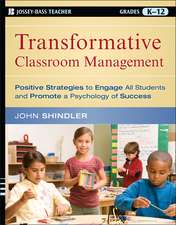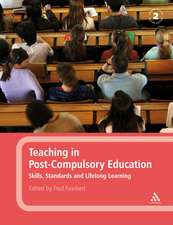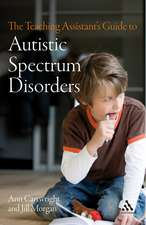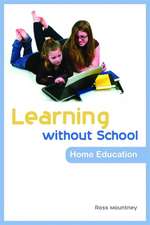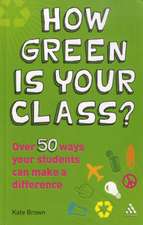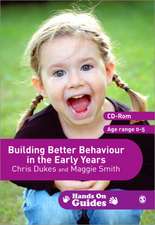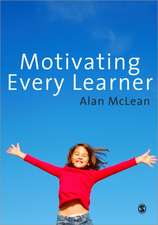Challenging Learning Through Dialogue: Strategies to Engage Your Students and Develop Their Language of Learning: Corwin Teaching Essentials
Autor James A. Nottingham, Jill Nottingham, Martin Rentonen Limba Engleză Paperback – 11 ian 2017
Using classroom discussions to teach good habits of thinking
Research shows that classroom discussion has a major effect on student learning. So, how do we get students to talk more? Challenging Learning Through Dialogue transforms the most up-to-date research into practical strategies that work. Readers will learn
- How to build in more "wait-time" for better quality thinking and questioning from students
- How to use dialogue to teach reasoning, collaboration, and good habits of thinking
- The three types of dialogue and how to teach the most effective version: exploratory talk
- Dozens of practical strategies for exploratory dialogue
- Global examples of fun ways to teach dialogue
Din seria Corwin Teaching Essentials
-
 Preț: 245.65 lei
Preț: 245.65 lei -
 Preț: 282.10 lei
Preț: 282.10 lei -
 Preț: 247.32 lei
Preț: 247.32 lei -
 Preț: 275.93 lei
Preț: 275.93 lei -
 Preț: 245.90 lei
Preț: 245.90 lei -
 Preț: 189.99 lei
Preț: 189.99 lei -
 Preț: 281.39 lei
Preț: 281.39 lei -
 Preț: 216.12 lei
Preț: 216.12 lei -
 Preț: 278.11 lei
Preț: 278.11 lei -
 Preț: 165.87 lei
Preț: 165.87 lei -
 Preț: 280.37 lei
Preț: 280.37 lei -
 Preț: 269.07 lei
Preț: 269.07 lei -
 Preț: 185.60 lei
Preț: 185.60 lei -
 Preț: 154.25 lei
Preț: 154.25 lei -
 Preț: 271.26 lei
Preț: 271.26 lei -
 Preț: 196.64 lei
Preț: 196.64 lei -
 Preț: 278.94 lei
Preț: 278.94 lei -
 Preț: 277.02 lei
Preț: 277.02 lei -
 Preț: 192.18 lei
Preț: 192.18 lei -
 Preț: 274.24 lei
Preț: 274.24 lei -
 Preț: 216.34 lei
Preț: 216.34 lei -
 Preț: 188.51 lei
Preț: 188.51 lei -
 Preț: 228.06 lei
Preț: 228.06 lei -
 Preț: 288.05 lei
Preț: 288.05 lei -
 Preț: 239.30 lei
Preț: 239.30 lei -
 Preț: 279.41 lei
Preț: 279.41 lei -
 Preț: 272.03 lei
Preț: 272.03 lei -
 Preț: 278.94 lei
Preț: 278.94 lei -
 Preț: 175.41 lei
Preț: 175.41 lei -
 Preț: 290.66 lei
Preț: 290.66 lei -
 Preț: 196.96 lei
Preț: 196.96 lei -
 Preț: 270.70 lei
Preț: 270.70 lei -
 Preț: 276.91 lei
Preț: 276.91 lei -
 Preț: 276.20 lei
Preț: 276.20 lei -
 Preț: 269.35 lei
Preț: 269.35 lei -
 Preț: 85.05 lei
Preț: 85.05 lei -
 Preț: 191.94 lei
Preț: 191.94 lei -
 Preț: 269.35 lei
Preț: 269.35 lei -
 Preț: 245.41 lei
Preț: 245.41 lei -
 Preț: 185.60 lei
Preț: 185.60 lei -
 Preț: 268.25 lei
Preț: 268.25 lei -
![Answers to Your Biggest Questions About Creating a Dynamic Classroom: Five to Thrive [series]](https://i3.books-express.ro/bs/9781071856789/answers-to-your-biggest-questions-about-creating-a-dynamic-classroom.jpg) Preț: 235.33 lei
Preț: 235.33 lei -
 Preț: 284.13 lei
Preț: 284.13 lei -
 Preț: 196.17 lei
Preț: 196.17 lei -
 Preț: 246.00 lei
Preț: 246.00 lei -
 Preț: 246.82 lei
Preț: 246.82 lei -
 Preț: 278.11 lei
Preț: 278.11 lei -
 Preț: 278.62 lei
Preț: 278.62 lei -
 Preț: 277.85 lei
Preț: 277.85 lei -
 Preț: 277.02 lei
Preț: 277.02 lei
Preț: 154.28 lei
Nou
Puncte Express: 231
Preț estimativ în valută:
29.52€ • 32.17$ • 24.88£
29.52€ • 32.17$ • 24.88£
Carte indisponibilă temporar
Doresc să fiu notificat când acest titlu va fi disponibil:
Se trimite...
Preluare comenzi: 021 569.72.76
Specificații
ISBN-13: 9781506376523
ISBN-10: 1506376525
Pagini: 208
Dimensiuni: 216 x 279 mm
Greutate: 0.52 kg
Ediția:1
Editura: SAGE Publications
Colecția Corwin
Seria Corwin Teaching Essentials
Locul publicării:Thousand Oaks, United States
ISBN-10: 1506376525
Pagini: 208
Dimensiuni: 216 x 279 mm
Greutate: 0.52 kg
Ediția:1
Editura: SAGE Publications
Colecția Corwin
Seria Corwin Teaching Essentials
Locul publicării:Thousand Oaks, United States
Recenzii
"We
know
that
teachers
do
too
much
of
the
talking
in
the
classroom,
and
they
know
it
too.
But
too
often
their
first
question
is
“How
do
we
get
students
to
talk
more?”
Nottingham,
Nottingham
and
Renton
have
helped
answer
that
question.Challenging
Learningis
filled
with
practical
advice
and
important
activities
that
will
help
increase
dialogue
in
classrooms!"
"This work from Nottingham, Nottingham, and Renton clearly demonstrates first how to create both the moral and instructional imperative to increase student voice and dialogue for meaning-making between teacher and student in all classrooms. They then articulate countless ways for how to do so in practical, meaningful, and relevant ways that allow any teacher to begin to do so tomorrow. This work should be in the hands of every teacher and administrator before they walk in your school."
"In my position as the gifted specialist I work with both students and teachers. I help support teachers in planning to meet the needs of my students, as well as working with beginning teachers. All would benefit from incorporating Dialogue in [their] content areas. This book could quite frankly change a lot of classroom practices–it wasn't preachy–it was informative and a great guide to engage students."
"This book is a great tool for educators interested in making dialogue work in the classroom. [It] is really clear and easy to follow with sample dialogue structures that teachers can use and examples to follow. I recommend it for individual educators, teams, [and] districts…"
"Like either side of a coin, language and thinking and inseparably entwined. Our thoughts direct our language and our language conveys our thoughts. Efficacious thinkers, therefore, enhance their thinking by enriching their linguistic capacities. And that is what this valuable book is about. It is a must for teachers and families who wish to have their children learn to think and communicate with greater precision and clarity. Filled with rich background information, myriad protocols, practical learning strategies, and vivid examples, this book can teach us all how to listen more attentively and to communicate more thoughtfully. It is what the world needs now."
"James Nottingham has masterfully explained what dialogue is and how to use it in the classroom through powerful strategies. These powerful strategies challenge students to engage in deep thinking and understanding. The myriad of examples bring the strategies to life and I could envision the possible student exchanges with the use of these strategies as I was reading."
"James Nottingham thinks most teachers do too much of the talking in the classroom. His newest offering from the Challenging Learning series is a stand-alone exploration of how to use reasonable, student-generated dialogue to move from surface-level learning to deep understanding. Nottingham uses relevant research, instructive examples, and a wealth of resource tools to help educators guide students in how to think rather than what to think. Regardless of grade level or discipline, teachers who want to hone their mastery skills will appreciate this useful book."
"Sitting among eager students engaged in what James Nottingham calls “exploratory talk” is, indeed, a thrilling experience, because we are witnessing authentic wonder, inquiry, critical thinking, and reflection all in pursuit of deeper understanding of complex issues and ideas. In this book Nottingham presents viable approaches for such talk, for learning how to think. One result is “to make us wobble,” not in commitment but in considering the thoroughness of all our thinking. This is a splendid contribution to our literature in these days where the matter of rigorous, performance standards is in much need of debate and dialogue."
"The best kinds of teaching books do three things: show me what I'm doing; cast a compelling vision for how I could be doing it better; and provide me practical tools for turning the present reality into the compelling vision. With those criteria, I can only call this a new member of the best kinds of teaching books. I am eager to infuse dialogue into the speaking and listening work my students and I do together."
"This book reminds teachers of the power of dialogue to develop deeper learning. It provides a groundbreaking framework with specific strategies teachers can use as they move students toward deeper understanding through dialogue."
"James Nottingham’s work onChallenging Learningis a critical element of creating Visible Learners. This new series will help teachers hone the necessary pedagogical skills of dialogue, feedback, questioning, and mindset. There’s no better resource to encourage all learners to know and maximize their impact!"
"Challenging Learning Through Dialogueprovides educators with meaningful, purposeful, and practical strategies to create high quality dialogue. Underpinned by extensive educational research, these methods will help students achieve deep level thinking and learning through the power of our language. It is inspiring, insightful, and a MUST read for all educators. Absolutely Brilliant!"
"This work from Nottingham, Nottingham, and Renton clearly demonstrates first how to create both the moral and instructional imperative to increase student voice and dialogue for meaning-making between teacher and student in all classrooms. They then articulate countless ways for how to do so in practical, meaningful, and relevant ways that allow any teacher to begin to do so tomorrow. This work should be in the hands of every teacher and administrator before they walk in your school."
"In my position as the gifted specialist I work with both students and teachers. I help support teachers in planning to meet the needs of my students, as well as working with beginning teachers. All would benefit from incorporating Dialogue in [their] content areas. This book could quite frankly change a lot of classroom practices–it wasn't preachy–it was informative and a great guide to engage students."
"This book is a great tool for educators interested in making dialogue work in the classroom. [It] is really clear and easy to follow with sample dialogue structures that teachers can use and examples to follow. I recommend it for individual educators, teams, [and] districts…"
"Like either side of a coin, language and thinking and inseparably entwined. Our thoughts direct our language and our language conveys our thoughts. Efficacious thinkers, therefore, enhance their thinking by enriching their linguistic capacities. And that is what this valuable book is about. It is a must for teachers and families who wish to have their children learn to think and communicate with greater precision and clarity. Filled with rich background information, myriad protocols, practical learning strategies, and vivid examples, this book can teach us all how to listen more attentively and to communicate more thoughtfully. It is what the world needs now."
"James Nottingham has masterfully explained what dialogue is and how to use it in the classroom through powerful strategies. These powerful strategies challenge students to engage in deep thinking and understanding. The myriad of examples bring the strategies to life and I could envision the possible student exchanges with the use of these strategies as I was reading."
"James Nottingham thinks most teachers do too much of the talking in the classroom. His newest offering from the Challenging Learning series is a stand-alone exploration of how to use reasonable, student-generated dialogue to move from surface-level learning to deep understanding. Nottingham uses relevant research, instructive examples, and a wealth of resource tools to help educators guide students in how to think rather than what to think. Regardless of grade level or discipline, teachers who want to hone their mastery skills will appreciate this useful book."
"Sitting among eager students engaged in what James Nottingham calls “exploratory talk” is, indeed, a thrilling experience, because we are witnessing authentic wonder, inquiry, critical thinking, and reflection all in pursuit of deeper understanding of complex issues and ideas. In this book Nottingham presents viable approaches for such talk, for learning how to think. One result is “to make us wobble,” not in commitment but in considering the thoroughness of all our thinking. This is a splendid contribution to our literature in these days where the matter of rigorous, performance standards is in much need of debate and dialogue."
"The best kinds of teaching books do three things: show me what I'm doing; cast a compelling vision for how I could be doing it better; and provide me practical tools for turning the present reality into the compelling vision. With those criteria, I can only call this a new member of the best kinds of teaching books. I am eager to infuse dialogue into the speaking and listening work my students and I do together."
"This book reminds teachers of the power of dialogue to develop deeper learning. It provides a groundbreaking framework with specific strategies teachers can use as they move students toward deeper understanding through dialogue."
"James Nottingham’s work onChallenging Learningis a critical element of creating Visible Learners. This new series will help teachers hone the necessary pedagogical skills of dialogue, feedback, questioning, and mindset. There’s no better resource to encourage all learners to know and maximize their impact!"
"Challenging Learning Through Dialogueprovides educators with meaningful, purposeful, and practical strategies to create high quality dialogue. Underpinned by extensive educational research, these methods will help students achieve deep level thinking and learning through the power of our language. It is inspiring, insightful, and a MUST read for all educators. Absolutely Brilliant!"
Cuprins
List
of
Figures
The Challenging Learning Story
Foreword by Douglas Fisher
Acknowledgments
About the Authors
Contributors
Introduction
The Language of Learning
Chapter 1: Why Dialogue?
1.0 Why Dialogue?
1.1 Reasons for Dialogue 1: Learning How to Think
1.2 Reasons for Dialogue 2: From Surface to Deep
1.3 Reasons for Dialogue 3: Creating a Climate of Trust
1.4 Reasons for Dialogue 4: Developing Language to Express Understanding
1.5 Review
1.6 Next Steps
Chapter 2: Dialogue Essentials
2.0 Dialogue Basics
2.1 Putting Dialogue in the Context of Educational Objectives
2.2 The Hidden Classroom
2.3 Active Engagement
2.4 Conditions for Successful Dialogue
2.5 Language for Dialogue
2.6 Exploratory Talk
2.7 Review
2.8 Next Steps and Further Reading
Chapter 3: Dialogue to Engage Students
3.0 Preview
3.1 Getting the Ethos Right
3.2 Issuing Invitations
3.3 Encouraging and Engaging
3.4 Restating
3.5 Reformulating
3.6 Review
3.7 Next Steps and Further Reading
Chapter 4: One Way to Learn How to Think: Develop Reasoning
4.0 Preview
4.1 The Language of Reasoning
4.2 Developing the Language of Reasoning
4.3 Process of Reasoning
4.4 Routines to Develop Reasoning
4.5 Developing a Reasoning Repertoire
4.6 Reasoning Moves
4.7 Review
4.8 Next Steps
Chapter 5: Dialogue Groupings
5.0 Preview
5.1 Dialogue Groupings
5.2 Ground Rules for Dialogue Groups
5.3 Whole-Group Dialogue
5.4 Splitting Large Groups Into Two
5.5 Small-Group Dialogues With a Teacher
5.6 Small-Group Dialogues Without a Teacher
5.7 Final Word About Groupings
5.8 Review
5.9 Next Steps and Further Reading
Chapter 6: Dialogue Detectives
6.0 Preview
6.1 Appointing Dialogue Detectives
6.2 Clues to Detect: Focusing on Performance
6.3 Clues to Detect: Focusing on Thinking Structures
6.4 Other Clues to Detect
6.5 Review
6.6 Next Steps and Further Reading
Chapter 7: Dialogue Structures
7.0 Preview
7.1 Paired Dialogue
7.2 Opinion Lines
7.3 Opinion Corners
7.4 Choosing Corners
7.5 Talking Heads
7.6 Jigsaw Groups
7.7 Clustering
7.8 Review
7.9 Next Steps and Further Reading
Chapter 8: Mysteries
8.0 Preview
8.1 Mysteries
8.2 Running a Mystery
8.3 Mysteries in Practice
8.4 Questioning Cause and Effect Within Mysteries
8.5 Reviewing a Mystery Using the SOLO Taxonomy
8.6 Writing Your Own Mysteries
8.7 Review
8.8 Next Steps and Further Reading
8.9.1 Mystery: Should Bjørn Move to France?
8.9.2 Mystery: Louis Pasteur and the Anthrax Vaccine
8.9.3 Mystery: Is Sally a Good Friend?
Chapter 9: Odd One Out
9.0 Preview
9.1 Odd One Out
9.2 Benefits of Odd One Out
9.3 How to Use Odd One Out Effectively
9.4 Why and When to Use Odd One Out
9.5 Odd One Out Variations
9.6 Odd One Out Examples
9.7 Extending Odd One Out With Venn Diagrams
9.8 Review
9.9 Next Steps and Further Reading
Chapter 10: Fortune Lines
10.0 Preview
10.1 Fortune Lines
10.2 Using Fortune Lines
10.3 Fortune Line of Henry VIII
10.4 Fortune Line for a Visit to Grandma's
10.5 Review
10.6 Next Steps and Further Reading
Chapter 11: Philosophy for Children (P4C)
11.0 Preview
11.1 Philosophy for Children
11.2 The Community of Inquiry
11.3 Philosophical Questions
11.4 Dialogue Through P4C
11.5 P4C Sequence—Overview
11.6 P4C Sequence—In Depth
11.7 Review
11.8 Next Steps and Further Reading
Chapter 12: Dialogue Exercises in P4C
12.0 Preview
12.1 Dialogue Exercises
12.2 Make a Choice, Give a Reason
12.3 Concept Stretching: Fairness
12.4 Review
12.5 Next Steps and Further Reading
Appendix 1. Dialogue Detectives
Appendix 2. Louis Pasteur Script
Repertoire and Judgment Notes
References
Index
The Challenging Learning Story
Foreword by Douglas Fisher
Acknowledgments
About the Authors
Contributors
Introduction
The Language of Learning
Chapter 1: Why Dialogue?
1.0 Why Dialogue?
1.1 Reasons for Dialogue 1: Learning How to Think
1.2 Reasons for Dialogue 2: From Surface to Deep
1.3 Reasons for Dialogue 3: Creating a Climate of Trust
1.4 Reasons for Dialogue 4: Developing Language to Express Understanding
1.5 Review
1.6 Next Steps
Chapter 2: Dialogue Essentials
2.0 Dialogue Basics
2.1 Putting Dialogue in the Context of Educational Objectives
2.2 The Hidden Classroom
2.3 Active Engagement
2.4 Conditions for Successful Dialogue
2.5 Language for Dialogue
2.6 Exploratory Talk
2.7 Review
2.8 Next Steps and Further Reading
Chapter 3: Dialogue to Engage Students
3.0 Preview
3.1 Getting the Ethos Right
3.2 Issuing Invitations
3.3 Encouraging and Engaging
3.4 Restating
3.5 Reformulating
3.6 Review
3.7 Next Steps and Further Reading
Chapter 4: One Way to Learn How to Think: Develop Reasoning
4.0 Preview
4.1 The Language of Reasoning
4.2 Developing the Language of Reasoning
4.3 Process of Reasoning
4.4 Routines to Develop Reasoning
4.5 Developing a Reasoning Repertoire
4.6 Reasoning Moves
4.7 Review
4.8 Next Steps
Chapter 5: Dialogue Groupings
5.0 Preview
5.1 Dialogue Groupings
5.2 Ground Rules for Dialogue Groups
5.3 Whole-Group Dialogue
5.4 Splitting Large Groups Into Two
5.5 Small-Group Dialogues With a Teacher
5.6 Small-Group Dialogues Without a Teacher
5.7 Final Word About Groupings
5.8 Review
5.9 Next Steps and Further Reading
Chapter 6: Dialogue Detectives
6.0 Preview
6.1 Appointing Dialogue Detectives
6.2 Clues to Detect: Focusing on Performance
6.3 Clues to Detect: Focusing on Thinking Structures
6.4 Other Clues to Detect
6.5 Review
6.6 Next Steps and Further Reading
Chapter 7: Dialogue Structures
7.0 Preview
7.1 Paired Dialogue
7.2 Opinion Lines
7.3 Opinion Corners
7.4 Choosing Corners
7.5 Talking Heads
7.6 Jigsaw Groups
7.7 Clustering
7.8 Review
7.9 Next Steps and Further Reading
Chapter 8: Mysteries
8.0 Preview
8.1 Mysteries
8.2 Running a Mystery
8.3 Mysteries in Practice
8.4 Questioning Cause and Effect Within Mysteries
8.5 Reviewing a Mystery Using the SOLO Taxonomy
8.6 Writing Your Own Mysteries
8.7 Review
8.8 Next Steps and Further Reading
8.9.1 Mystery: Should Bjørn Move to France?
8.9.2 Mystery: Louis Pasteur and the Anthrax Vaccine
8.9.3 Mystery: Is Sally a Good Friend?
Chapter 9: Odd One Out
9.0 Preview
9.1 Odd One Out
9.2 Benefits of Odd One Out
9.3 How to Use Odd One Out Effectively
9.4 Why and When to Use Odd One Out
9.5 Odd One Out Variations
9.6 Odd One Out Examples
9.7 Extending Odd One Out With Venn Diagrams
9.8 Review
9.9 Next Steps and Further Reading
Chapter 10: Fortune Lines
10.0 Preview
10.1 Fortune Lines
10.2 Using Fortune Lines
10.3 Fortune Line of Henry VIII
10.4 Fortune Line for a Visit to Grandma's
10.5 Review
10.6 Next Steps and Further Reading
Chapter 11: Philosophy for Children (P4C)
11.0 Preview
11.1 Philosophy for Children
11.2 The Community of Inquiry
11.3 Philosophical Questions
11.4 Dialogue Through P4C
11.5 P4C Sequence—Overview
11.6 P4C Sequence—In Depth
11.7 Review
11.8 Next Steps and Further Reading
Chapter 12: Dialogue Exercises in P4C
12.0 Preview
12.1 Dialogue Exercises
12.2 Make a Choice, Give a Reason
12.3 Concept Stretching: Fairness
12.4 Review
12.5 Next Steps and Further Reading
Appendix 1. Dialogue Detectives
Appendix 2. Louis Pasteur Script
Repertoire and Judgment Notes
References
Index
Notă biografică
James Nottingham is co-founder and director of Challenging Learning, a group of companies with 30 employees in 6 countries. His passion is in transforming the most up-to-date research into strategies that really work in the classroom. He is regarded by many as one of the most engaging, thought-provoking and inspirational speakers in education. His first book, Challenging Learning, was published in 2010 and has received widespread critical acclaim. Since then, he has written 6 books for teachers, leaders, support staff, and parents. These books share the best research and practice connected with learning; dialogue; feedback; the learning pit; early years education; and growth mindset. Before training to be a teacher, James worked on a pig farm, in the chemical industry, for the American Red Cross, and as a teaching assistant in a school for deaf children. At university, he gained a first-class honours degree in education (a major turnaround after having failed miserably at school). He then worked as a teacher and leader in primary and secondary schools in the UK before co-founding an award-winning, multi-million-pound regeneration project supporting education, public and voluntary organisations across north east England. Skolvärlden (Swedish Teaching Union) describes James as "one of the most talked about names in the world of school development" and the Observer newspaper in the UK listed him among the Future 500 - a "definitive list of the UK′s most forward-thinking and brightest innovators."
Descriere
Research
shows
that
classroom
discussion
has
a
major
effect
on
student
learning.
How
do
we
get
students
to
talk
more?Challenging
Learning
Through
Dialogueis
for
all
educators
who
aim
to
use
effective
classroom
dialogue
to
engage
students.


